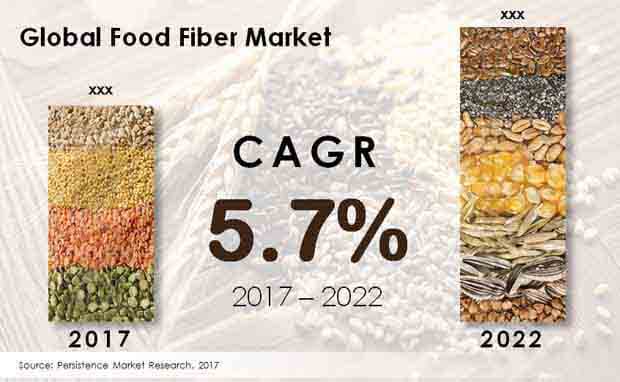Food Fiber Market
Industry: Food and Beverages
Published Date: September-2017
Format: PPT*, PDF, EXCEL
Delivery Timelines: Contact Sales
Number of Pages: 170
Report ID: PMRREP18487
The demands of consumers for food with nutritional value has escalated over past couple of years. The awareness regarding health benefits of food fibers has regulated and increased the consumption of food fibers from past few years. This is the major factor driving growth of the global food fiber market. There are several advantages of food fibers, which have a profound impact on growth of the global food fiber market.
They provide health benefits such as decreased level of cholesterol, normalized movement of bowels, controlling sugar level in the body, reduced risk of heart diseases, hypertension and obesity. They improve insulin sensitivity which is beneficial for patients suffering from diabetes. Also, consumption of food fibers helps in controlling duodenal ulcer, gastrophaegal reflux disease, constipation as well as hemorrhoids.
Moreover, changing lifestyle of consumers impacts eating habits, which calls for food fiber intake owing to increased awareness. This is backed up with a rise in disposable income of people worldwide, which has further triggered consumption of food fibers, contributing to growth of the global food fiber market.
Food fibers are set of selected compounds which cannot be directly digested by humans, are healthy, and have several functions in day-to-day diet.
They help in controlling obesity and regulate the overall functioning of the human body. Derived from fruits and plants, food fibers are advantageous to human beings with respect to physiology. It is recommended to consume a variety of foods with high fiber content to achieve huge health benefits.

According to Persistence Market Research, the global food fiber market is expected to reach a value of about US$ 6 Bn by the end of 2022, and is poised to propagate at a robust CAGR throughout the period of forecast 2017-2022.
North America is expected to remain dominant in the global food fiber market, in terms of revenues. As of 2017, North America showed high market attractiveness for food fibers, owing to high consumption. In addition, emerging economies such as Asia-Pacific excluding Japan (APEJ) is poised to grow at the highest growth rate during the period of forecast.
By product type, although sales of soluble corn fiber will register a relatively lower CAGR through 2022, it is expected to dominate the global food fiber market in terms of revenues. However, this segment is expected to witness a decline in its market share over the forecast period. Insulin segment has a comparatively higher market share than all other product segments, except for the soluble corn fiber. But, sales of insulin will exhibit a healthy growth throughout the forecast period. In terms of market share, being the second highest segment, insulin can be a much lucrative option to invest into in the coming years.
By application, the bakery and confectionery segment is expected to register the highest CAGR through 2022 The segment not only outruns other segments in terms of sales expansion, but is also expected to dominate the global market with a high market share by 2022 end.
The research report has profiled companies which are expected to remain active in the expansion of global food fiber market throughout 2022. Companies such as Cargill Inc., Tate & Lyle, Archer-Daniels-Midland Company, Ingredion Roquette Frères S.A., SunOpta Inc., Nexira, Kerry Group, Grain Processing Corporation and J. RETTENMAIER & SÖHNE GmbH, Co KG are profiled in this research report.
The global food fiber market is segmented based on product type, application, and region. A detailed market segmentation for food fibers is highlighted below.
| Attribute | Details |
|---|---|
| Region |
|
| Product Type |
|
| Application |
|
To know more about delivery timeline for this report Contact Sales
